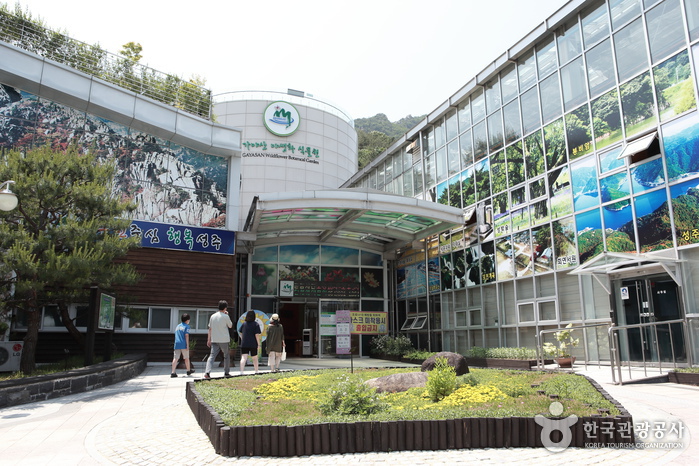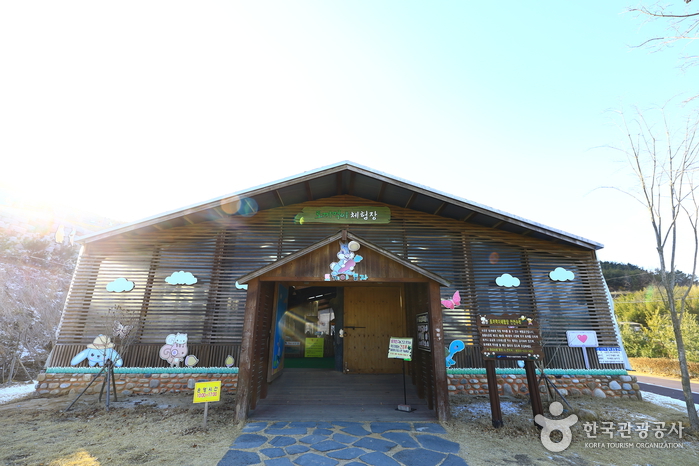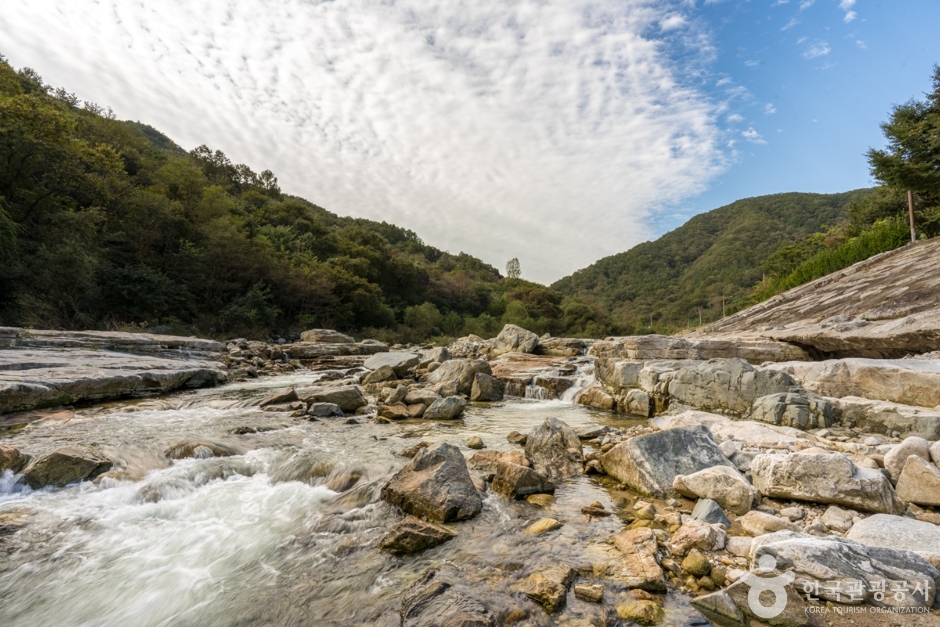Sangbiwon[Korea Quality] / 생비원[한국관광 품질인증/Korea Quality]
15.5Km 2020-12-10
28, Nori 2-gil, Deokgok-myeon, Goryeong-gun, Gyeongsangbuk-do
+82-10-6732-4578, +82-54-954-1528
Saengbiwon is a traditional hanok pension located 400 m above sea level on Gayasan Mountain, Goryeong, North Gyeongsang Province. Its picturesque front garden, full of clay pots and wildflowers, and the dried persimmon hanging on the porch come fall give the pension a comfortable, idyllic atmosphere. Clear water from the Sangbiri Valley flow near the pension and a footpath along the reservoir offer great opportunities to enjoy the nature of Gayasan Mountain. Opening the window brings one face-to-face with the four seasons of the mountain, while the pavilion in the garden emanates a cool, slow-paced enjoyment of nature. All water used in the pension is drawn from a natural mineral spring 150 m below the land, giving the water a crisp and refreshing taste.
The seven rooms of the pension, including the Dongbaek, Maehwa, Mongnyeon, Moran, and Hwangtobang are furnished with red clay and Cheongsong hanji (Korean traditional paper) interior, giving them a characteristic hanok look. Wooden wardrobes and thick cotton quilts bring in mind the image of a grandmother’s warm house. Two of the rooms are heated with traditional gudeul floor heating, which is a blessing in the biting heat of winter. All rooms have access to Wi-Fi, equipped with modern bathrooms, electric kettle, pressure rice cooker, and simple cooking utensils. Only the Hwangtobang room allows cooking within the room, and guests in other rooms must use the communal kitchen and barbeque areas. There is also an annex, which hosts exclusively group visitors and can be used as a seminar room and a training site. .
Saengbiwon’s other pride is the traditional sauces, made in house for four generations. Visitors can reserve an elegant Korean breakfast, served in brass tableware, made with Saengbiwon’s handmade sauce from Korean soybeans. Saengbiwon also offers programs like sauce-making, Korean malt candy-making, tofu-making, Korean sweets-making, and tea ceremony.
Odosan Healing Forest (오도산 치유의 숲)
15.6Km 2025-09-11
398, Odosanhyuyang-ro, Bongsan-myeon, Hapcheon-gun, Gyeongsangnam-do
+82-55-930-3742
Odosan Healing Forest is nestled at the foot of the tall Odosan Mountain (1,133 meters above sea level) in Hapcheon. The mountain spans the areas covering Gajo-myeon in Geochang-gun, Gyeongsangnam-do and Myosan-myeon and Bongsan-myeon in Hapcheon-gun, Gyeongsangnam-do. Odosan is at the end of the Gayasan Mountain Range along with Dumusan Mountain (1,039 meters above sea level), which is situated 2 kilometers to the northeast. North of Odosan Healing Forest, you will find Haeinsa Temple, home to the Tripitaka Koreana and one of the three major temples in Korea, as well as Gayasan Mountain, and Maehwasan Mountain. Hapcheonho Lake is south of the forest, so there are several tourist destinations in the area and the natural landscape is superb. The azaleas and royal azaleas are in full bloom in spring; cool valley waters can be enjoyed in summer; and the mountain's colorful fall foliage is as beautiful as that of Naejangsan Mountain, a renowned spot to enjoy autumn colors. You can enjoy mountain climbing along the valley surrounded by thick forests. It is said that Doseon, a well-known monk from the late Silla Dynasty, was fascinated by the energy and beauty of Odosan Mountain and practiced asceticism there.
Enjoying the Odosan Recreational Forest
Convenient facilities unfold along the valley within the Odosan Recreational Forest, such as the visitor information center, forest cabins, a communal kitchen, camp decks, campsites, etc. Notably, the hiking trail behind the forest cabins follows the clear stream that flows year-round, leading to Sukseongsan Peak, a small peak on the slope of Odosan Mountain. The trail overlooks Hapcheonho Lake and offers hikers a beautiful view. Odosan Recreational Forest consists of dense natural forests filled with pine and oak trees that are 20 to 50 years old. Also, a variety of vegetation, including the wild cherry, crimson glory vine (called meoru in Korea), and kiwiberry vine (called darae in Korea), as well as herbaceous plants can be found here. This makes it an ideal site for students, including teenagers, to learn about nature.
Nonggamatjip Mil (농가맛집 밀)
16.5Km 2024-02-23
1566 Deogun-ro, Suryun-myeon, Seongju-gun, Gyeongsangbuk-do
054-931-2660
Nonggamatjip Mil is located near Gayasan Wildflower Botanical Garden. This establishment serves dishes made from vegetables harvested from Gayasan Mountain, in-house produced honey, and agricultural products from Seongju. Their signature offering is the Mil hanjeongsik (Korean table d'hote), featuring borigulbi (barley-aged dried yellow croaker), grilled chicken, and japchae. Additionally, they offer handmade bowls, honey, and flower tea for sale.
Gayasan National Park (Baegundong Area) (가야산국립공원-백운동 지구)
16.6Km 2021-04-28
Baegun-ri, Seongju-gun, Gyeongsangbuk-do
+82-55-930-8000
Gayasan Mountain in Gyeongsangbuk-do was designated as a national park in 1972. The mountain's main peak, Chilbulbong Peak, towers at 1,433 meters. It borders Seongju-gun, Hapcheon-gun and Geochang-gun. In particular, the mountain range stretching along Suryun-myeon, Seongju-gun is famous for its scenic nature. Furthermore, the beautiful Gayasan Beltway, which extends from Suryun-myeon to Gayasan Mountain, highlights the splendor and grandeur of the precipitous crimson cliffs.
Hongryudonggyegok Valley (홍류동계곡)
16.7Km 2020-01-06
1502-9, Gayasan-ro, Gaya-myeon, Hapcheon-gun, Gyeongsangnam-do
+82-55-930-8000
The 4 km valley between the entrance of Gayasan Mountain National Park entrance and Haeinsa Temple is called Hongryudonggyegok Valley. It was named so because the leaves turn so crimson that the water of the valley reflects the color and appears crimson as well. This is the place where Chi-Won Choe, after returning from Dang China to Silla (BC 57-AD 935) found Korea in disarray. It was too much to bear for him so he retired to live privately with poetry until his death.
There are 19 famous places in Hongryudonggyegok Valley, including major cultural assets like Jongsangjeong Pavilion, Nakhwadam, and Bunokpok. The scenery of Nongsanjeong Pavilion, where Chi-Won Choe read poetry and played baduk, is especially beautiful. On the opposite side is a rock where you can see the handwring of Chi-Won Choe. The Yongmunpokpo Falls, located on the north end of the valley, has beautiful scenery with its harmonious blend of falling water and Giamgoiseok (fantastic rocks and stones).
The scenery of Hongryudonggyegok Valley changes every season, and it is the finest part of Gayasan Mountain. It is famous for the azaleas in full bloom during the spring, and for the thousand-year-old pine trees and broad-leaved trees growing thickly throughout the valley and the cool, clear water that runs through it during the summer. In the fall, the nearby pine tree forests and broad-leaved trees tinge in color and accentuate the crimson foliage of autumnal leaves, making the crimson reflection of the leaves in the valley water look like a rising flame, and shows why the valley was named Hongryudonggyegok Valley.
Gaya Hotel (가야호텔)
16.9Km 2025-01-07
52, Gayasansingmurwon-gil, Seongju-gun, Gyeongsangbuk-do
+82-54-931-3500
Gaya Hotel is located 560 meters above sea level on Gayasan Mountain in a pristine natural environment. The hotel also offers a sauna that uses natural mineral water. Near the hotel is the only Korean wild flower botanical garden.
Gayasan Wildflower Botanical Garden (가야산 야생화식물원)
16.9Km 2021-12-22
49, Gayasansingmurwon-gil, Seongju-gun, Gyeongsangbuk-do
+82-54-931-1264
Gayasan Wildflower Botanical Garden opened on June 16, 2006 as the nation's first botanical garden dedicated to wildflowers. The garden is home to over 400 plant species, ranging from wildflowers to trees, and serves as a cultural space with educational research and preservation training. In addition to the general exhibition hall, there is a greenhouse on the basement level. There are 92 tree types including pine, 54 bush types including royal azalea, and 257 wildflower types including windflowers. The garden is beautiful all year round, showcasing the changing of the seasons.
Santokki Park (산토끼 노래동산)
17.3Km 2023-06-27
623 , Ibang-ro, Changnyeong-gun, Gyeongsangnam-do
+82-0507-1352-1401
Santokki Park is a recreational space located behind Ibang Elementary School in Changnyeong-gun. The park was inspired by the children's song "Santokki," meaning mountain rabbit, composed and written by Lee Il-lae who was a staff at Ibang Elementary School. The park comprises a variety of things to do and see related to rabbits, including a rabbit village, rabbit cave, and rabbit feeding experience. There are also spaces dedicated to Lee Il-lae, his work, and small animals. The park is kids-friendly with recreational places where children can freely run around as well as other amenities that help visitors rest and relax.
Twelve Tablet Pavilion of Hyeonpung Gwak Clan (현풍곽씨십이정려각)
17.8Km 2020-04-14
3, Jidong-gil, Dalseong-gun, Daegu
+82-53-668-3162
Designated as Daegu’s Cultural Property No. 29 on May 12, 1995, Twelve Tablet Pavilion of Hyeonpung Gwak Clan (Jongnyeo-gak of the Hyeonpung Lineage of the Kwak Clan) was built in the mid-Joseon period during King Yeongjo's rule. The pavilion houses 12 Jeongnyeo-gak tablets awarded to the members of the Gwak Clan from the time of King Seonjo in 1598 to the time of King Yeongjo.
It is an important and unique hertiage because the Gwak Clan attained their 12 Jeongnyeo-gak tablats all in one village, which is quite uncommon. During the Joseon dynasty, Jeongnyeo-gak tablets were awarded to honor loyal retainers, devoted sons, and exemplary husbands and wives.
Daegacheongyeogok Valley (Muheulgugok) (대가천계곡(무흘구곡))
18.0Km 2024-02-23
Sincheong-ri, Suryun-myeon, Seongju-gun, Gyeongsangbuk-do
Daegacheongyeogok Valley starts just past Seongju Dam and winds its way towards Cheongamsagyegok Valley in Gimcheon city. The valley's crystal-clear waters, combined with its unique rock formation, creates a spectacular view. Its broad expanse, gentle flow, and shallow depths make it a popular summer getaway. Lifeguards are on duty from early June to late August, providing safety for visitors. Additionally, the nearby Gayasan Mountain and Dogyongsanseong Fortress are worth exploring.
![Sangbiwon[Korea Quality] / 생비원[한국관광 품질인증/Korea Quality]](http://tong.visitkorea.or.kr/cms/resource/83/2651483_image2_1.jpg)





 English
English
 한국어
한국어 日本語
日本語 中文(简体)
中文(简体) Deutsch
Deutsch Français
Français Español
Español Русский
Русский